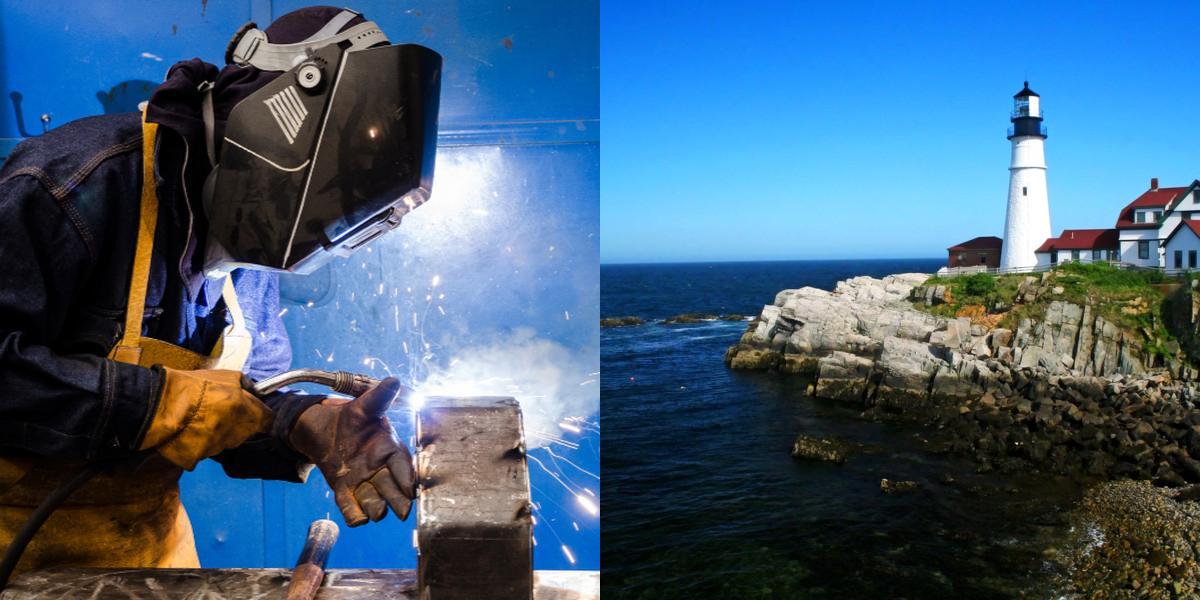How to Become a Welder in Maine

Welders are skilled professionals who use heat and tools to join and shape metal parts. They work in a variety of industries, including construction, manufacturing, and automotive. As a welder, your main responsibilities will include reading blueprints, operating welding equipment, and inspecting finished products for quality.
How do I get my Welder certification?
If you're considering a career as a welder, one of the first steps you'll need to take is to obtain your welder certification. This certification is a standard requirement for most employers in the welding industry, as it demonstrates your competency and skill level as a welder.
To get your welder certification, you'll need to complete a formal training program and pass a certification exam. Here are the steps you can follow to obtain your welder certification:
-
Research Welding Programs: Start by researching welding programs in your area. Look for accredited schools, community colleges, or vocational schools that offer comprehensive welding programs. These programs should cover a range of welding techniques and provide hands-on training.
-
Enroll in a Welding Program: Once you've identified a suitable welding program, enroll in the program and complete the required coursework. The duration of the program can vary, but most programs can be completed within six months to two years, depending on the level of certification you're seeking.
-
Gain Hands-on Experience: While completing your welding program, take advantage of any opportunities to gain hands-on experience. This could include participating in welding workshops, internships, or apprenticeships. The more practice you get, the better prepared you'll be for the certification exam.
-
Study for the Certification Exam: As you near the end of your welding program, start studying for the certification exam. The American Welding Society (AWS) is the leading organization that offers welding certifications. They provide detailed information on the exam content and study materials on their website.
-
Take the Certification Exam: Once you feel confident in your knowledge and skills, schedule your certification exam. The exam will typically consist of a written portion and a practical welding test. The written portion will test your theoretical knowledge of welding principles and techniques, while the practical test will assess your ability to perform various welding tasks.
-
Receive Your Certification: If you pass both parts of the certification exam, you will receive your welder certification. This certification will typically be valid for a specific period, such as six months to two years, depending on the certification level. To maintain your certification, you may need to complete continuing education courses or re-take the certification exam periodically.
By following these steps, you can obtain your welder certification and demonstrate your expertise as a welder to potential employers.
How do I get a job as a Welder?
Once you've obtained your welder certification, the next step is to find a job as a welder. Here are some steps you can take to increase your chances of finding employment as a welder:
-
Build a Strong Resume: Start by creating a professional resume that highlights your welding skills, certifications, and any relevant work experience. Include details of the welding techniques you're proficient in, such as MIG welding, TIG welding, or arc welding. Also, mention any specialized welding certifications you may have obtained.
-
Network: Networking is an essential part of finding a job as a welder. Attend industry events, join professional welding associations, and connect with other welders and industry professionals. Building relationships and connections can help you learn about job opportunities and get referrals.
-
Search for Job Openings: Use online job boards, industry-specific websites, and local classifieds to search for job openings in your area. Many companies also post job openings on their websites, so be sure to check those as well. You can also reach out to local welding shops, construction companies, or manufacturing plants directly to inquire about job openings.
-
Apply for Apprenticeships or Entry-Level Positions: If you're just starting your welding career, consider applying for apprenticeships or entry-level positions. These opportunities can provide you with valuable on-the-job training and experience. Even if the starting pay may be lower, the experience gained can help you advance in your career.
-
Prepare for Interviews: Once you start receiving interview invitations, take the time to prepare for them. Research the company you're interviewing with, practice answering common interview questions, and be ready to demonstrate your welding skills if necessary. Dress professionally and arrive on time for the interview.
-
Show Your Skills: During the interview process, be prepared to showcase your welding skills. Some employers may require a welding test as part of the interview process. This is an opportunity for you to demonstrate your abilities and impress potential employers with your welding technique and attention to detail.
-
Continue Learning and Improving: The welding industry is constantly evolving, with new techniques and technologies being introduced. To stay competitive and increase your job prospects, continue learning and improving your skills. Attend workshops, take additional certification courses, and stay up-to-date with industry trends.
By following these steps and being proactive in your job search, you can increase your chances of finding a job as a welder and kick-starting your welding career.
Career Paths and Opportunities after Becoming a Welder
Once you've become a certified welder and gained some experience in the field, there are various career paths and opportunities you can explore. Here are a few options to consider:
-
Welding Inspector: If you have a keen eye for detail and a strong understanding of welding standards and codes, you may consider becoming a welding inspector. Welding inspectors are responsible for ensuring that welds meet quality and safety standards. This role requires additional certifications and training beyond basic welding skills.
-
Welding Supervisor or Foreman: As you gain experience and demonstrate leadership skills, you may be promoted to a welding supervisor or foreman position. In this role, you'll oversee a team of welders, coordinate projects, and ensure work is completed according to specifications and timelines.
-
Welding Educator: If you enjoy teaching and sharing your knowledge with others, you could pursue a career as a welding educator. This could involve teaching at a vocational school, community college, or offering private welding classes. Additional certifications and a strong understanding of welding theory and techniques are typically required for this role.
-
Welding Engineer: For those interested in the technical aspects of welding and welding processes, a career as a welding engineer may be a good fit. Welding engineers are involved in the design, development, and improvement of welding processes and equipment. This role requires advanced education and specialized training.
-
Specialized Welding: As a certified welder, you may choose to specialize in a particular type of welding or industry. For example, you could specialize in underwater welding, aerospace welding, or pipeline welding. Specializing in a niche area can open up unique career opportunities and potentially higher-paying jobs.
-
Entrepreneurship: If you have the desire to be your own boss, starting your own welding business could be an option. This would involve setting up your own workshop, attracting clients, and managing your business operations. Entrepreneurship requires not only welding skills but also business acumen and marketing knowledge.
These are just a few examples of the career paths and opportunities available to certified welders. The welding industry offers a wide range of possibilities, and with dedication, continuous learning, and hard work, you can advance in your career and achieve your professional goals.
How much does a Welder make?
The average salary for a welder can vary depending on factors such as experience, location, and industry. According to the U.S. Bureau of Labor Statistics (BLS), the median annual wage for welders, cutters, solderers, and brazers was $43,410 as of May 2020. The lowest 10 percent earned less than $30,860, while the highest 10 percent earned more than $64,240.
Starting salaries for welders can vary greatly. Entry-level welders with little to no experience may start at or near the lower end of the salary range. However, as they gain experience and develop their skills, their earning potential increases.
Final Thoughts
Becoming a certified welder is a rewarding and promising career choice. By completing a formal welding program, obtaining your welder certification, and gaining hands-on experience, you can lay the foundation for a successful career in welding. Remember to continuously improve your skills, stay up-to-date with industry trends, and explore different career paths to maximize your opportunities in the welding industry.
Are you thinking about a job change or wanting to learn more about different career paths? Feel free to check out these additional articles:

Joanna Paragas is part of the Growth team at Dreambound. Her primary role involves creating various automation to streamline workflows and make tasks more efficient for the entire team. Beyond her professional endeavors, Joanna enjoys spending her free time playing with her dogs and enhancing her knowledge by enrolling in online courses.



